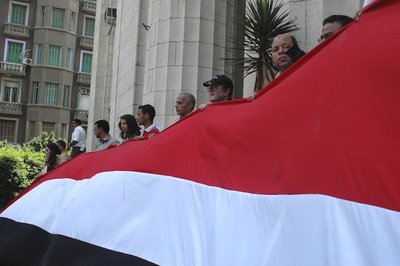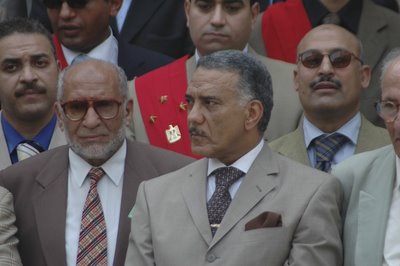
[Pillars of Justice - The Judges Club outside the High Court]
This afternoon, two demonstrations of discontent took place within a hundred metres of each other. The first was a vocal and unusually well attended Kifaya! protest on the steps of the Journalists' Syndicate. The second was ten minutes of a silent photo-op on the steps of the High Court from members of the pro-reform Judges' Club.
The first was of a style that has become familiar to activists, journalists and state security over the past couple of years. Slogans, energy, an atmosphere of latent confrontation with the state. Down with Hosni Mubarak, Down with Habib al-Adli. A symbol of ordinary people moved to action by the conditions of injustice in which they find themselves.
The second was of a less familiar style, and was a political statement of a different order of magnitude from the first. This is not to belittle the efforts of Kifaya! and the various organisations who have so bravely and for so long stared down the barrell of state security, but to point out that the nature of the authoritarian state defines even the method of protest against it.
In common with other protest groups, the pro-reform judges led by Zakariya Abdel Aziz do a little symbolic appropriation for effect. Everyone claims ownership of the Egyptian flag - the difference in the judges' case is that they can afford one thirty metres long. And, as is their right as an integral part of the machinery of state, they display proudly the badges of their institution - green sashes, lapel pins and the like. The last symbol is somewhat more elusive, but is evident in the silken handkerchiefs adorning well-tailored suits, dark sunglasses, and the air of well-fed upper-class confidence. They are the symbols of an elite - just not, as it happens, the ruling one.

[A long, long flag of Egypt winds its way up the steps of the High Court]

[Members of the Egyptian Judges' Club assemble to quietly make their point]

[Club President Zakariya Abdel Aziz solemnly leads his colleagues]

[Judges prefer silent protest]
The several hundred of these individuals who stood on the steps of the High Court were an imposing and impressive sight. They were aware of the value of the photo-op, aware of the weight of their station, and aware of the effect of their thus deployed symbols. They are an element of the state unwilling to accede to the notion that the executive is the state.
So whether this dignified battallion represents a coming fight for a meaningful system of justice in this country, or whether such thing has already been lost, time will tell. But today made so very obvious the fact that if the opposition movements are ever to achieve anything against the control of the Mubarak regime, they need symbols like these.

No comments:
Post a Comment